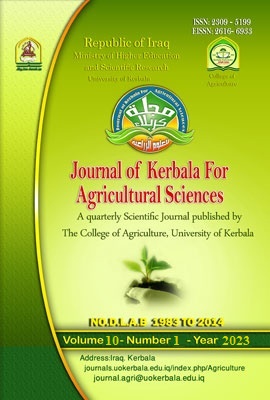Association of the ANXA9 gene with milk production and its components in Awassi sheep
DOI:
https://doi.org/10.59658/jkas.v10i3.1130Keywords:
Awassi sheep, ANXA9 gene, Daily milk yield, Lactation period, milk compositionAbstract
The study was conducted in the sheep farm of the Al-Fayhaa station in the Jableh sub-district / Al-Musaib project (55 km south of Baghdad), as well as the Biotechnology Laboratory in the College of Agricultural Engineering Sciences / University of Baghdad for the period from 5/1/2022 to 30/10/2022. With the aim of detection the ANXA9 gene polymorphism and its relationship to Daily milk yield (DMY), Lactation period and milk composition, as well as the Polymorphism distribution and allele frequency in 52 Awassi sheep and its lambs, three polymorphism appeared in this variant (T>G SNP) which are TT, TG and GG, and their percentage were 51.92, 40.38 and 7.69%, and the differences between them were highly significant (P≤0.01), with a frequency of 0.72 and 0.28 for the T and G alleles, respectively. the daily milk production rate of Awassi ewes was affected significantly (P≤0.05) by the ANXA9 gene polymorphism, the first variation (T>G SNP), for ewes with the TG polymorphism (1128.65 g), while the components of milk were not affected significantly except for the percentage of Fat, which was maximum in the milk of ewes for GG and TT genotype (5.67 and 5.64%).We can conclude by studying the ANXA9 gene polymorphism that they can be adopted in developing strategies for genetic improvement of sheep, and the application of the study to a larger sample and to several sites and extracting the interaction between two SNPs would give more accurate results and determine the best method for managing and improving sheep flocks.
Downloads
Published
How to Cite
Issue
Section
License
Copyright (c) 2023 Copyright (c) 2024 is the Author's article. Published by the Journal of Kerbala for Agricultural Sciences under a CC BY 4.0 license

This work is licensed under a Creative Commons Attribution 4.0 International License.
Licensing Terms
All articles are published under a Creative Commons License and will be directed to the Creative Commons Attribution 4.0 International License (CC BY 4.0) That permits use, distribution, and reproduction in any medium, provided the original work is properly cited. This license also allows the work to be used for commercial purposes.
Use by both non-commercial and commercial users
This content is licensed under a Creative Commons Attribution 4.0 International (CC BY 4.0) license, permitting use by both non-commercial and commercial users. Individual users may access, download, copy, display, and redistribute the articles to colleagues, as well as adapt, translate, and text- and data-mine the content, subject to the following conditions:
- The author's moral rights, including the right of attribution and the right to protect their work from derogatory treatment, are respected.
- Where content in the article is identified as belonging to a third party, users must ensure that any reuse complies with the copyright policies of the owner of that content.
- If the article content is reused for research or educational purposes, users should maintain a link to the appropriate bibliographic citation, including the DOI and a link to the published version on the journal's website.






